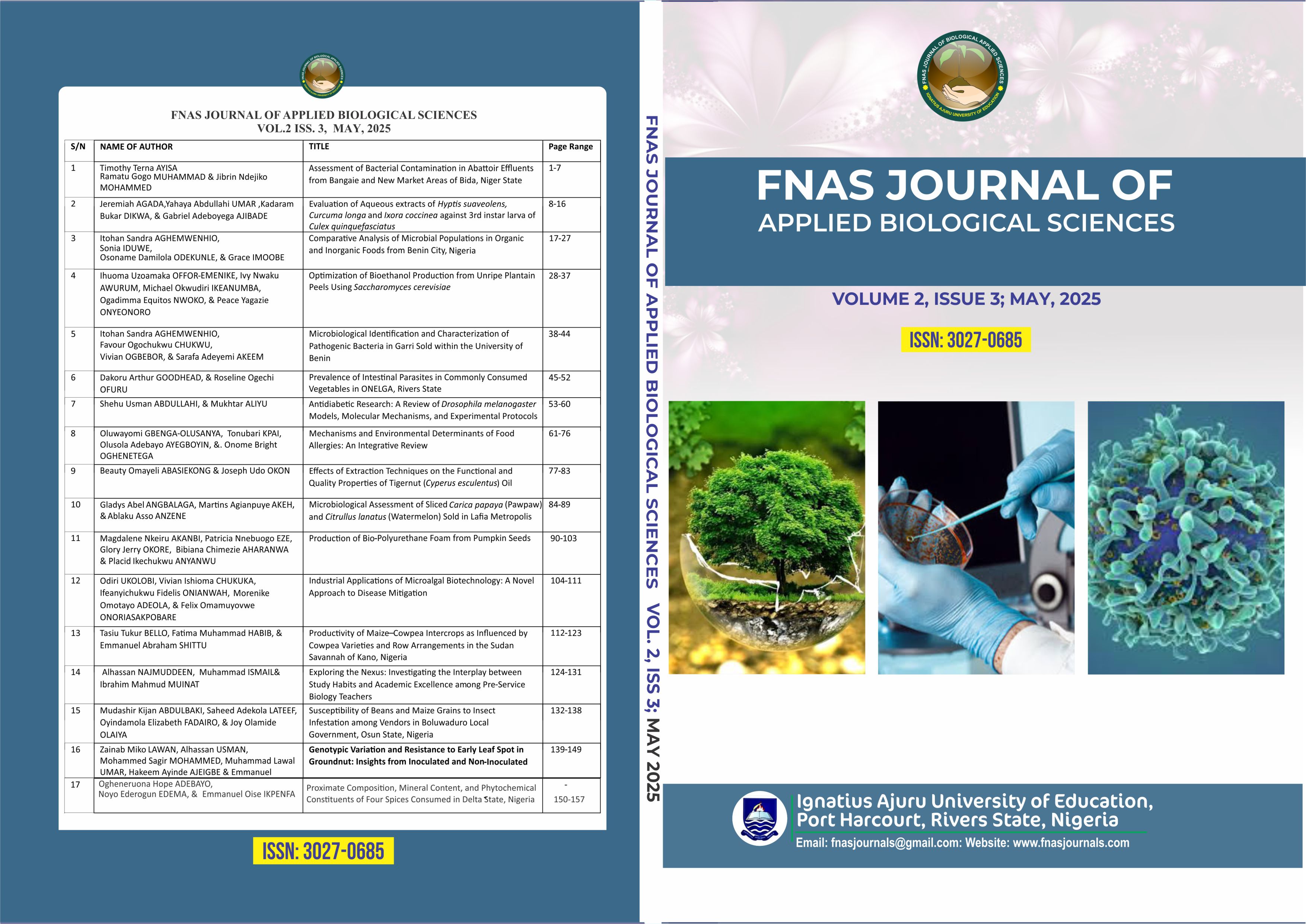Microbiological Assessment of Sliced Carica papaya (Pawpaw) and Citrullus lanatus (Watermelon) Sold in Lafia Metropolis
DOI:
https://doi.org/10.63561/jabs.v2i3.936Keywords:
Carica papaya, Citrullus lanatus, Food hygiene, Lafia Metropolis, Microbial AssessmentAbstract
Fresh fruits are essential components of a healthy diet due to their high content of vitamins, minerals, and antioxidants. Among these, Carica papaya (pawpaw) and Citrullus lanatus (watermelon) are particularly valued for their nutritional benefits. This study assessed the microbiological contamination of sliced pawpaw and watermelon sold in Lafia Metropolis using standard microbiological procedures. For Carica papaya, total bacterial counts (TBC) ranged from 3.4 × 10⁴ to 3.8 × 10⁴ CFU/g, while total fungal counts (TFC) ranged from 1.9 × 10³ to 2.3 × 10³ CFU/g. For Citrullus lanatus, the TBC ranged from 4.0 × 10⁴ to 4.4 × 10⁴ CFU/g, and the TFC from 2.9 × 10³ to 3.2 × 10³ CFU/g. A statistically significant association was observed across the variables for both fruits among the selected locations (p < 0.001). The bacterial isolates from Carica papaya included Staphylococcus aureus, Escherichia coli, Salmonella spp., Pseudomonas aeruginosa, and Bacillus cereus, while fungal isolates included Aspergillus niger, Penicillium spp., Candida spp., Fusarium spp., and Rhizopus stolonifer. The bacterial profile of Citrullus lanatus was similar, except that Listeria monocytogenes was also isolated; fungal isolates were identical to those from Carica papaya. These findings highlight the need for stringent hygiene practices during the handling and sale of sliced fruits in Lafia Metropolis to safeguard public health. It is recommended that food regulatory bodies create awareness and educate the public on the health risks associated with consuming such contaminated fruits.
References
Abadias, M., Usall, J., Anguera, M., Solsona, C., & Vinas, I. (2008). Microbiological quality of fresh, minimally processed fruit and vegetables, and sprouts from retail establishments. International Journal of Food Microbiology, 123(1-2), 121−129. DOI: https://doi.org/10.1016/j.ijfoodmicro.2007.12.013
Abdulkareem, T. O., & Odeh, J. E. (2021). Microbial analysis of sliced watermelon, pineapple and pawpaw from five location markets in Ilorin. Global Scientific Journal, 9(4), 3003–3014. https://www.globalscientificjournal.com
Alegbeleye, O. O., Singleton, I., & Sant’Ana, A. S. (2018). Sources and contamination routes of microbial pathogens to fresh produce during field cultivation: A review. Food Microbiology, 73, 177−208. DOI: https://doi.org/10.1016/j.fm.2018.01.003
Barth, M., Hankinson, T. R., Zhuang, H., & Breidt, F. (2009). Microbiological spoilage of fruits and vegetables. Compendium of the Microbiological Spoilage of Foods and Beverages, 135−183. https://doi.org/10.1007/978-1-4419-0826-1_6 DOI: https://doi.org/10.1007/978-1-4419-0826-1_6
Bintsis, T. (2021). Microbial pollution and food safety. AIMS Microbiology, 4(3), 377−396. https://doi.org/10.3934/microbiol.2018.3.377 DOI: https://doi.org/10.3934/microbiol.2018.3.377
Cheesbrough, M. (2006). District laboratory practice in tropical countries (2nd ed., Part 2, pp. 434–438). Cambridge University Press. DOI: https://doi.org/10.1017/CBO9780511543470
European Food Safety Authority. (2019). Listeria monocytogenes contamination of ready-to-eat foods and the risk for human health in the EU. European Food Safety Authority Journal, 17(1), e05554. https://doi.org/10.2903/j.efsa.2019.5554 DOI: https://doi.org/10.2903/j.efsa.2019.5554
Jariyah, R., Kusumaningtyas, E., & Budiono, T. (2020). The potential of papaya (Carica papaya) leaves as an anti-dengue herbal remedy: A literature review. Journal of Health Research, 34(1), 39−45.
Nguyen-The, C., & Carlin, F. (1994). The microbiology of minimally processed fresh fruits and vegetables. Critical Reviews in Food Science and Nutrition, 34(4), 371−401. https://doi.org/10.1080/10408399409527668 DOI: https://doi.org/10.1080/10408399409527668
Nwachukwu, E., Ezeama, C. F., & Ezeanya, B. N. (2008). Microbiology of polyethylene-packaged sliced watermelon (Citrullus lanatus) sold by street vendors in Nigeria. African Journal of Microbiology Research, 2(8), 192−195.
Odebisi-Omokanye, M. B., Oke, M. A., Ahmed El-Imam, A. M., Ajijolakewu, A. K. & Salaudeen, B. I. (2015). Microbiological Quality and Safety of pre-cut fruit retailed in Ilorin, Kwara State, Nigeria. Fountain Journal of Natural and Applied Sciences, 4(1), 19 – 26. DOI: https://doi.org/10.53704/fujnas.v4i1.52
Olu-Taiwo, M., De-Graft, B. M., & Forson, A. O. (2021). Microbial quality of sliced pawpaw (Carica papaya) and watermelon (Citrullus lanatus) sold on some streets of Accra Metropolis, Ghana. International Journal of Microbiology, 2021, Article 6695957. https://doi.org/10.1155/2021/6695957 DOI: https://doi.org/10.1155/2021/6695957
Perkins-Veazie, P., Collins, J. K., & Davis, A. R. (2021). Watermelon consumption increases plasma arginine concentrations in adults. Nutrients, 13(8), 2874.
Reddy, K. R. N., Reddy, C. S., & Muralidharan, K. (2010). Detection of Aspergillus spp. and aflatoxin B1 in rice in India. Food Microbiology, 27(1), 30−34. DOI: https://doi.org/10.1016/j.fm.2008.07.013
Sango, D. M., Abuga, R. O., & Obonyo, M. (2016). Microbial quality and safety of fresh fruits and vegetables: The Kenyan perspective. African Journal of Food Science, 10(8), 162−170. https://doi.org/10.5897/AJFS2015.1468
Sharma, M., Lakshmanan, S., Rice, E. W., & Bae, J. (2022). Sources of microbiological contamination of fresh produce: Implications for research and education on agricultural best practices. Critical Reviews in Food Science and Nutrition, 62(4), 769−784. https://doi.org/10.1080/10408398.2020.1818076
Uzor, C. A., & Dick, A. A. (2022). Bacteriological assessment of sliced fruits (pawpaw, pineapple and watermelon) sold in Rumuokwuta Market. Direct Research Journal of Agriculture and Food Science, 10(5), 126–130. https://doi.org/10.26765/DRJAFS11832443





